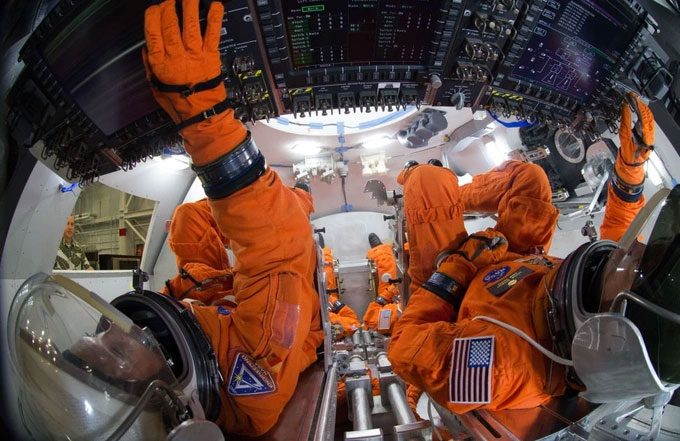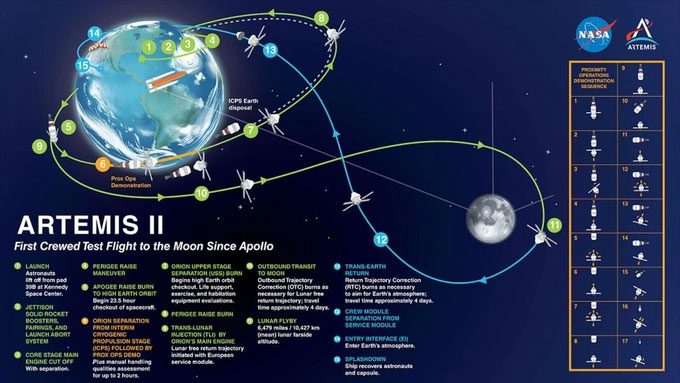The astronauts in the Artemis-2 mission are working hard to complete NASA’s training program in preparation for their lunar flight scheduled for November.
According to information from NASA, the four astronauts selected for the Artemis-2 mission are entering a rigorous training phase to ensure they have the physical fitness and necessary skills for their lunar journey in November 2024.

The 4 astronauts participating in the Artemis-2 mission. (Photo: NASA).
The Artemis-2 Mission is set to take four astronauts close to and around the Moon’s orbit. The spacecraft used for this mission is the Orion spacecraft.
This vehicle will be launched by the Space Launch System (SLS) rocket from Launch Pad 39B at the Kennedy Space Center in Florida, USA.
This is considered the closest step for NASA to land humans on the Moon in the Artemis-3 mission, which is expected to take place at the end of 2025. The crew for Artemis-2 includes Commander Reid Wiseman, Pilot Victor Glover, and mission specialists Christina Koch and Jeremy Hansen.
Recently, Jacki Mahaffey, the training lead, revealed some details about NASA’s training process for the Artemis-2 mission. This expert stated that the training process will last for at least 18 months.
The exercises in this training program are designed to ensure that astronauts are fully prepared with the knowledge to handle unexpected situations, as well as to incorporate new procedural changes.
According to a document released by NASA, candidates are required to pass a swimming test during the first month of training. They must swim a total of 75 meters in a pool without stopping. After that, they must swim while wearing a spacesuit and athletic shoes.
Additionally, candidates must adapt to low and high-pressure environments and learn how to respond to emergency situations that may arise under these conditions.

The Artemis-2 mission will take astronauts to the Moon and back to Earth in a journey expected to last 10 days. (Photo: NASA).
Throughout the training process, the crew will also enhance their understanding of various activities, including aerial escape, underwater escape, practicing with medical equipment, high-intensity workouts, and food preparation.
The majority of the crew training will take place at the Johnson Space Center, located in Houston, Texas, where there are complete Orion spacecraft models and necessary modules.
This expert further noted that hundreds of individuals are involved in the training for Artemis-2. This is because the training program not only directly instructs astronauts but also includes specific roles for ground systems.
The driving factor for NASA to implement this program is that the vehicles and equipment used for the Artemis mission are significantly different from those used during the Apollo era.
From small details like buttons, switches, and touch screens to revolutionary changes made in materials, power supply, and life support systems, all require time to become familiar with.
Mahaffey stated that one challenge the Artemis-2 crew faces is that the Orion spacecraft has never had human crew members before. In previous missions, Orion only carried some test equipment to evaluate the spacecraft’s structural integrity.

An engineer in a spacesuit performing activities inside the Orion model at the Johnson Space Center. (Photo: NASA).
However, according to a NASA representative, one advantage the Artemis crew has compared to the Apollo era is the accumulated experience over nearly 23 years from hundreds of astronauts who have worked at the International Space Station (ISS).
Furthermore, the mission does not include a landing on the Moon. Therefore, astronauts need not be concerned with landing activities but can focus most of their time on operating the spacecraft.
Mahaffey emphasized that the Artemis-2 mission is not a landing mission. Instead, the main objective of the mission is to test life support capabilities aboard the Orion spacecraft and to serve as a “stepping stone” for more significant missions ahead.
As of now, the Orion spacecraft has completed a total of two space missions, the most recent being Artemis-1 launched at the end of 2022.


















































